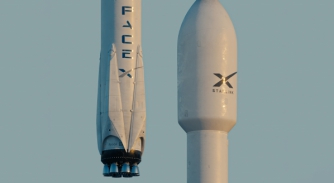Cellular connectivity in the superyacht realm
With a myriad of connectivity options now available, Valour Consultancy's Joshua Flood assesses the current state of the market and its future…

Following a recent report on maritime cellular technologies, Joshua Flood, Senior Research Consultant at Valour Consultancy, dissects an extract of some of its findings, with juicy insights from insiders in the marketplace, exclusively for SuperyachtNews.
Valour Consultancy recently completed a report on cellular technologies in the maritime market. The study covered merchant shipping in North Europe, offshore energy assets in the Gulf of Mexico, ocean cruise vessels, ‘floating cities’ in the Caribbean, fishing factories in the North Sea, and leisure vessels, such as superyachts. Getting to speak to companies serving these ‘cornucopia of the seas’ is always intriguing and insightful.
The American rock band Good Charlotte has a song called ‘Lifestyles of the Rich and Famous’. The song implies that these types of people are moaners, but my experience from this report and previous discussions is quite the opposite.
Some key findings
The global leisure market consists of the largest volume of vessels for cellular connectivity. Valour Consultancy estimates more than 18,600 active cellular subscriptions by leisure vessels worldwide in 2023. The technology is prevalent in any vessel undertaking coastal journeys.
Approximately one in five vessels use a maritime service provider for their cellular connectivity solutions, and this is likely due to the size of the vessel. In these cases, cellular connectivity is a back-up solution to VSAT – GEO or LEO.
Maritime service providers versus direct to mobile operators
We believe the cut-off size from a vessel going directly to those who use a maritime service provider is around 30 metres. However, this all depends on your customer base. Speaking to OmniAccess (a division of Marlink Group), it only serves superyachts above 50 metres. But this maritime service provider has a premium clientele list and is guarded, rightly so, about its customers.
As stated earlier, the larger the superyacht, the more likely it will use a maritime service provider. This, simply put, “If you can buy a vessel that costs tens of millions of dollars and pay the wages of ten plus staff, looking at cutting corners on your vessel’s connectivity’s quality of service doesn’t make sense”; so stated an interviewee. These larger superyachts can consume, on average, 2TB of data of cellular data a month, and that is just back-up. Depending on the vessel’s region, this could be a monthly charge of $3,000 in the Mediterranean or $24,000 in the Caribbean.
The bigger and more luxurious the vessel, the less likely the wealthy owner will want to deal with the inconvenience of shopping for different monthly data sim deals. Outsourcing this task makes life easier. In the words of one North American maritime service provider, “Stop fiddling with the cellular router hardware, MAKE THE PHONE CALL to us!”
Additionally, if the vessel is being used for commercial use/chartering, it must provide a very good service for its guests. Bad reviews on Trustpilot could hinder your boat’s yearly return on investment. Thinking of Good Charlotte, perhaps this may have been a motive for their hit song.
As such, if there are problems, reporting and remedying these with a maritime service provider will be much easier than trying to call Vodaphone Spain or Italy.
Cellular monthly fees
A good example of this from our figures is the monthly average revenue per user (ARPU) for cellular contracts from a maritime service provider around $648 (this across all leisure vessels), compared to $113 for mobile operators directly in 2022 (same again).
Nevertheless, there are a number of smaller vessels, and these will indubitably source their solutions from mobile operators directly. We estimated that 14,500 vessels were using mobile operator-sourced deals in 2023, and we project this portion of the market to continue to grow in the coming years. By 2032, nearly 20,000 vessels will be sourcing cellular connectivity from mobile operators.
Readers should note the majority of mobile operator sim deals are actually for residential use. This means there are no service level agreements (SLAs) on the quality of service, nor a guarantee of service. Craft hopping between islands needs to have multiple sims. But it is cheap. Another company highlighted that it’s similar to a Moroccan bazaar. There are definitely great deals to be had, but you have to be quick, and you will likely get hot, frustrated and annoyed in the process. It’s all about the ability to spot a deal. If Donald Trump is unsuccessful in the US Presidential elections later this year, he may have an excellent substitute profession as a cellular broker – The Art of The Deal.
Unsurprisingly, the biggest two regions of cellular subscriptions were Europe and the Caribbean region. Combined, both regions accounted for 56% of the total revenues worldwide.
We estimated Europe had more than 7,000 leisure vessels using cellular connectivity services. A large number of these vessels will be operating around the Mediterranean, and a regional hub for maritime service providers is Mallorca, where multiple connectivity service providers are based.

"The elephant in the room for all maritime connectivity discussions, Starlink has definitely made superyachts rethink how much they are spending and whether they can do things differently," says Flood.
Contradictions
Interestingly, I was speaking to a North European maritime service provider CEO. He is very well known in the industry and he only uses his yacht in the Scandi seas. But he refuses to put any connectivity technologies on board his vessel. Luckily, this collaborates with my findings that most of the cellular active vessels are in the Mediterranean.
Caribbean
Exploring further away from Europe, the Caribbean region is another hotbed for superyachts, and we estimate a market of nearly 5,000 leisure vessels had active cellular subscriptions in 2023. Previously, in 2021 and 2022, we believed these vessels had the highest monthly ARPU fees, but we have reduced this significantly in 2023 and further in our timelines. This is due to many vessels now picking Starlink’s services directly through service providers or integrators. Some service providers have reported a decline in their cellular costs of around 80% since Starlink Maritime’s launch.
The Caribbean is dominated by two key mobile operators. Digicel is the primary incumbent, and FLOW, wholesale prices per GB from the operator, are a factor of eight or nine times higher than US European mobile operators. The deployment of Starlink Maritime, particularly in the earlier stages of this commercial launch, the second half of 2022, has looked to balance up the scales.
What is fascinating is the recent announcement of Starlink and Peplink’s partnership. To some, this news may be insignificant, particularly in regard to the leisure boat segment. But I will tell you two things that will change this. Peplink is one the leading cellular router manufacturers in the maritime industry, but it has the highest market share in the leisure vessel market compared to merchant, offshore energy, cruise, fishing, etc. – nearly half of the cellular equipment. Starlink’s partnering with Peplink has opened the door to more than trebling its vessel count in the segment.
Starlink
The elephant in the room for all maritime connectivity discussions, Starlink has definitely made superyachts rethink how much they are spending and whether they can do things differently. As such, maritime service providers cannot take for granted that those with deep pockets will not look for value for money or lower pricing where possible. They got that wealthy for a reason.
Another leisure maritime service provider specialist, e3 Systems, has developed a clever connectivity management system called eHUB that manages the use of global ‘pay as you use’ 4G/5G SIMs as a back-up to Starlink or future upcoming LEO services. This includes automatic failover and bonding with these 4G/5G services so these services are only used and charged for when required, saving the captain and crew the challenges of managing multiple connectivity modes.
Backing up some of our earlier points, e3 commented, “The Caribbean is by far more expensive than the Mediterranean for 4G/5G service. Starlink’s maritime service provides the same performance and is the same cost in both regions. This is why you want your service provider to a vessel’s connectivity system to be both reliable and optimise the best prices for performance and location.”
It is important also to note that although Starlink technically works everywhere there are political and legal reasons why it cannot be used in certain countries. Russia and China are good examples of the service being prohibited.
Conclusion – is the future of cellular technologies in maritime over?
With cellular markets in the Caribbean in decline, and even more LEO VSAT capacity to come online in the future., some people believe cellular has had its peak already.
When making conclusions into a binary outcome, you are likely to shoot yourself in the foot. And like any clever, wise politician, I will avoid the question.
We believe the deployment of 5G will definitely make a difference, particularly in the hardware ecosystem of cellular in the maritime. Cellular in Europe and the US is price competitive with LEO, and this is the nature of the battle. Can service providers and operators make the economics of cellular services stand up?
In the Caribbean, wholesale cellular prices will need to be reduced. Talk of a congested satellite market has not materialised yet. This will take some flexibility from the cellular ecosystem.
However, the growing popularity of LEO services, presently Starlink, and soon OneWeb and Kuiper, have made maritime service providers diversify their services.
OmniAccess now has a cybersecurity SOC in its headquarters; it serves more than 500 merchant and yachting vessels, too, as well as its superyacht clients. The company also manages vessels’ on-board networks, right up to the access point. This means its service team can spot a minuscule problem in an access point in a specific cabin on a superyacht before the crew, owner or guests even notice, negating anyone having to make a phone call to shore.
Cellular services are also better for video calls due to lower latency. Online stock trading is another key application which demands good latency. But one point did stick with me during my research calls with the leisure service providers, when the children of these billionaires are on board playing computer games. Latency is king! If you want to win at Fortnite, cellular connectivity trumps the other options.
Valour Consultancy is a multi-award-winning provider of high-quality market intelligence and consultancy services. Its latest study, “The Future Market of Cellular Technologies (5G) in Maritime– 2023”, was developed with input from more than 40 companies across the value chain: ship management, ship operators, mobile operators, service providers, satellite operators, cellular router and antenna manufacturers.
The study offers detailed insights into the market dynamics: drivers, inhibitors, technology trends and the competitive environment, while market estimates and forecasts are provided out to 2032, contained in more than 50 tables and charts.
NEW: Sign up for SuperyachtNewsweek!
Get the latest weekly news, in-depth reports, intelligence, and strategic insights, delivered directly from The Superyacht Group's editors and market analysts.
Stay at the forefront of the superyacht industry with SuperyachtNewsweek
Click here to become part of The Superyacht Group community, and join us in our mission to make this industry accessible to all, and prosperous for the long-term. We are offering access to the superyacht industry’s most comprehensive and longstanding archive of business-critical information, as well as a comprehensive, real-time superyacht fleet database, for just £10 per month, because we are One Industry with One Mission. Sign up here.
Related news

Intellian to enhance OneWeb’s network
The global connectivity providers have partnered on the launch of the Intellian flat panel terminals for use on OneWeb’s maritime network
Business

OneWeb introduces LEO satellite service for maritime sector
The announcement, made at the Nor-Shipping event in Oslo, is expected to deliver more than 100Mbps of internet speed
Technology

Elcome offers Starlink internet to yachts
Starlink is one of the most significant advancements in communications for the maritime industry in decades
Business

Fusion connectivity
Jens Ploch, CCO of OmniAccess, explains the unique partnership with Starlink
Technology

Marlink adds SpaceX’s Starlink to its services
Marlink and OmniAccess will act as global “authorized Starlink integrators” for maritime and enterprise customers.
Business
Related news
Intellian to enhance OneWeb’s network
2 years ago
Elcome offers Starlink internet to yachts
3 years ago
Fusion connectivity
3 years ago
Marlink adds SpaceX’s Starlink to its services
3 years ago
NEW: Sign up for
SuperyachtNewsweek!
Get the latest weekly news, in-depth reports, intelligence, and strategic insights, delivered directly from The Superyacht Group's editors and market analysts.
Stay at the forefront of the superyacht industry with SuperyachtNewsweek



